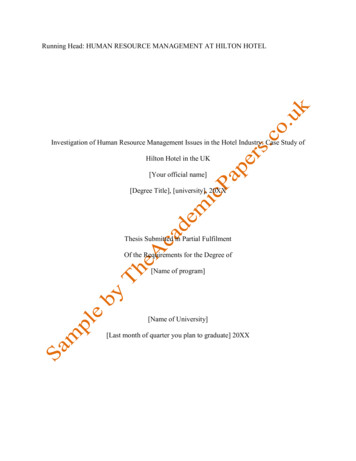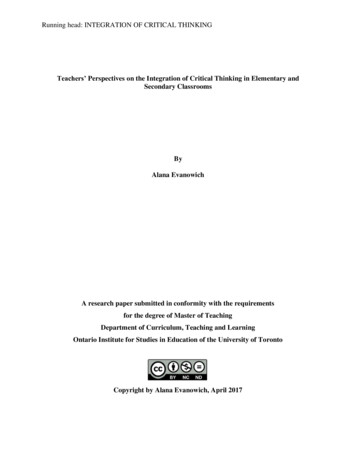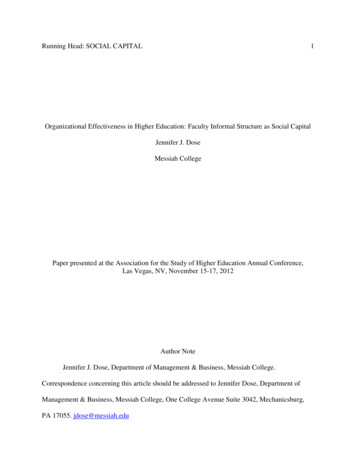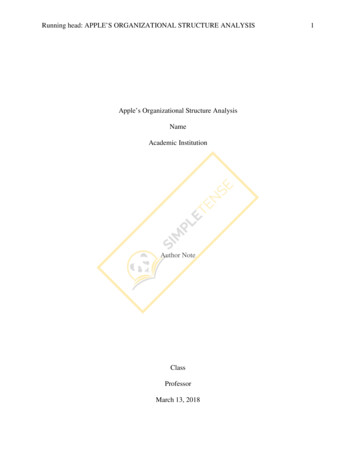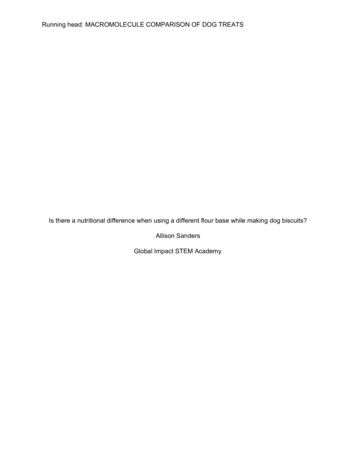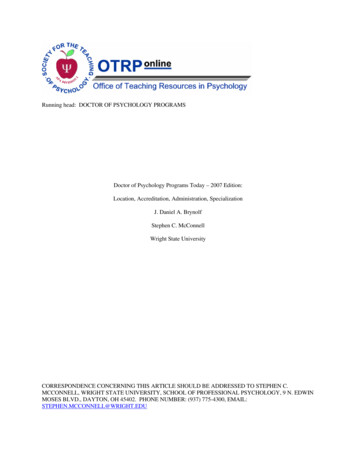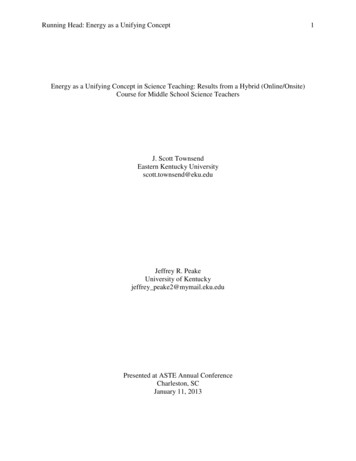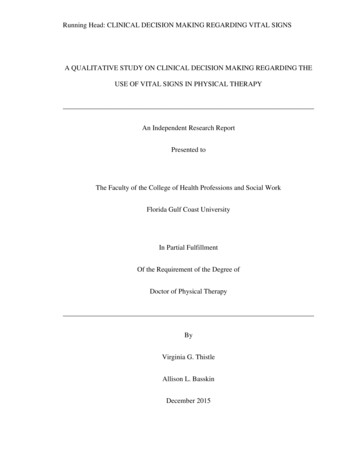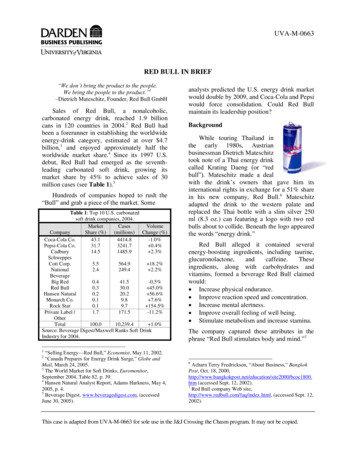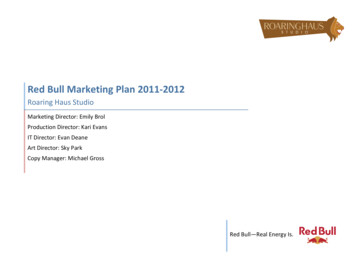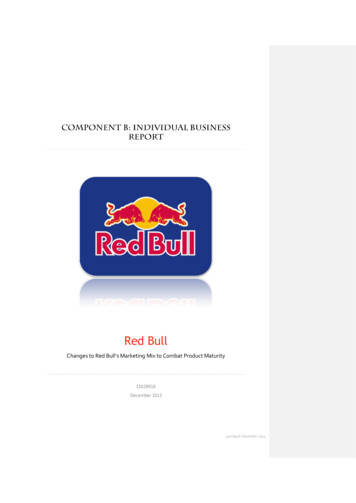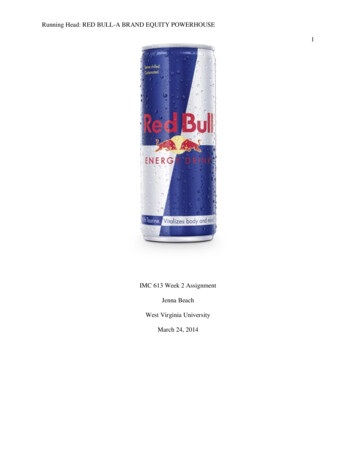
Transcription
Running Head: RED BULL-A BRAND EQUITY POWERHOUSE1IMC 613 Week 2 AssignmentJenna BeachWest Virginia UniversityMarch 24, 2014
RED BULL: A BRAND EQUITY POWERHOUSE2Red Bull: A Brand Equity PowerhouseRed Bull GMBH, an Austrian privately held company, is the largest global producer of energydrinks, and is currently headquartered in Fuschl am See, Salzburg (Caffeine Informer, 2013; Red Bull,n.d.d). The Red Bull Energy Drink was first launched in 1985 by Dietrich Mateschitz, a formermarketing manager for Procter & Gamble (Keller, 2003). Since its inception, Red Bull has beeninstrumental in providing functional energy to a large global demographic including college students,athletes, professionals, truck drivers, and clubbers. Today, Red Bull is available in more than 166countries and has sold over 40 billion cans (Red Bull, n.d.d).Sources of Brand EquityOver the past 26 years, Red Bull has developed and maintained strong brand equity. Building thefoundation for brand equity originates with consumer experiences, feelings, and beliefs as well as theperceptions and images. Red Bull continues to effectively apply Keller’s concept of customer-basedbrand equity (CBBE). CBBE involves “understanding the needs and wants of consumers andorganizations and devising products and programs to satisfy them are at the heart of successfulmarketing” (Keller, 2013b). A number of brand elements and benefits combined with global brandawareness, recognition, and a positive brand image have greatly influenced a stronger brand equity.Brand ElementsNot only has the global empire evolved over the years, the Red Bull formula has been improvedto include energy enhancing ingredients such as caffeine, B vitamins, sucrose and glucose, taurine, andAlpine spring water. Red Bull packs its patented formula in a convenient “slender silver-and-blue 250mL can” (Keller, 2003). The packaging, colors, and logo have also remained the same since 1987. TheRed Bull logo is an Oriental theme of two red bulls headed for collision in front of the sun and isrecognizable to consumers across the world (Keller, 2003). Figure 1 below illustrates the currentpackaging for the Red Bull Energy Drink. Together, the brand elements craft a unique brand associationbetween Red Bull and its consumers that help support brand equity.
RED BULL: A BRAND EQUITY POWERHOUSE3Figure1. Current Red Bull PackagingRed Bull recognizes the need for sustained energy throughout the day whether it is for athletesperforming in extreme sporting events, a professional trying to get through a busy day inthe office, a truck driver feeling alert on the road, or a student concentrating on a schoolassignment. Red Bull products satisfy consumers with benefits including enhancedphysical endurance, stimulated metabolism, improved feeling of well-being, betterreaction time and concentration, as well as increased mental alertness (Keller, 2003). Inother words, “Red Bull vitalizes body and mind” (Keller, 2003). With respect to productpricing, Red Bull has always pursued a premium pricing strategy. The product is pricedabove its competitors and costs an average of 1.99 to 3.00 per can. Consumers are willing to spendmore money for Red Bull drinks because they have brand associations of the product and responsive to itsbenefits.Continuing Brand EquityDespite the market or country, the sources of brand equity do not change. Since 1987, Mateschitzhas meticulously employed the same, consistent marketing message and strategy of Red Bull and itsproducts. In 1995, Red Bull entered the U.K. market and did not initially have success selling itsproducts. The key reason for its delayed success was a result of the company not utilizing its traditionalword-of-mouth strategy. Over time, Red Bull was able to recover by making the necessary changes withits marketing plans. In 2001, the U.K. was the “second-largest market by volume and sales” (Keller,2003). Since the strategic U.K. marketing mistakes, the company has not veered from its marketingstrategy. Providing a consistent brand message throughout various markets and countries has beencritical in maintaining Red Bull’s sources of brand equity.MarketingThe marketing program greatly contributes to Red Bull’s strong brand equity. “When you havestrong brand equity, your customers will buy more from you, they'll recommend you to other people,they're more loyal, and you're less likely to lose them to competitors” (Mind Tools, n.d.). Without the
RED BULL: A BRAND EQUITY POWERHOUSE4aggressive marketing of its products, Red Bull consumers would likely not be as brand loyal as they havebeen over the years. Their purchase behavior would have been greatly diminished, and the brand equitywould not be as strong as it is today.Brand AwarenessRed Bull is well-known for its participation and sponsorship with extreme sports and eventswhich helps heighten brand awareness; therefore, establishing CBBE with its consumers and nonconsumers. “Customer-based brand equity occurs when the customer has a high level of awareness andfamiliarity with the brands and holds some strong, favorable, and unique brand associations in memory”(Keller, 2013c). Brand awareness is one of the sources of brand equity that Red Bull has efficaciouslyachieved for over two decades. Through repeated exposure, Red Bull has increased familiarity of thebrand worldwide, which has helped set the tone for multiple sources of brand equity. “Anything thatcauses consumers to experience one of a brand’s element–its name, symbol, logo, character, packing, orslogan, including advertising and promotion, sponsorship and event marketing, publicity and publicrelations, and outdoor advertising–can increase familiarity and awareness of that brand element” (Keller,2013d).In 2012, Red Bull captured the attention of the world with the Red Bull Stratos which may havebeen the “most successful marketing campaign of all time” (Chun, 2012). Austrian dare devil andskydiver, Felix Baumgartner, “became the first person to break the sound barrier, starting in a freefall128,000 feet above the Earth that reached a high speed of 833.9 miles per hour” (Chun, 2012). Red Bullwas the official sponsor of the Stratos, also widely recognized as the ‘space jump,’ and was successfull ingenerating international brand awareness through marketing and social media. “According to ABCNews, besides YouTube, the jump was shown by more than 40 TV stations and 130 digital outlets. RedBull’s Facebook post-jump photo of Baumgartner gained almost 216,000 likes, 10,000 comments andover 29,000 shares within 40 minutes, and half the worldwide trending topics on Twitter were related toRed Bull Stratos” (Chun, 2012). Figure 2 below is the Facebook page for the Red Bull Stratos whichshares the journey of the infamous space jump with audiences worldwide.
RED BULL: A BRAND EQUITY POWERHOUSE5Figure 2. Red Bull Stratos Facebook PageNot only has Red Bull been instrumental in creating brand awareness with the Stratos, “thecompany is known for its buzz-oriented marketing geared toward youth, including extreme sports eventssuch as the Red Bull Air Race, sports team ownerships including international Red Bull soccer teams anda Red Bull Records label” (Chun, 2012).Brand RecognitionSince Red Bull was first launched, a number of competitors have entered the market, includingMonster, Rockstar, and Full Throttle. Despite a saturation of energy drink offerings, Red Bull haseffectively crafted the capability for consumers to remember and recognize the Red Bull brand. Whenconsumers are searching for an energy drink, previous exposure to the brand through various marketingefforts has greatly affected consumers’ ability to recall the brand. Throughout Red Bull’s history, thecompany has remained true to its original marketing strategy which includes “traditional television, printand radio advertising, event marketing in sports and entertainment, sampling and point-of-purchasepromotion” (Keller, 2003). A large majority of the global population can recognize the brand’s originalslogan, ‘Red Bull gives you wiiings which originates from ‘Red Bull verleiht Flüüügel’ (Keller, 2003).Additionally, Red Bull’s untraditional use of cartoons in advertising has also been influential in brandrecognition. Figure 2 and 3 are great examples of Red Bull’s traditional marketing strategies
RED BULL: A BRAND EQUITY POWERHOUSE6Figure 2Red Bull Gives You Wiiings Cartoon CommercialFigure 3Red Bull's RB7 launch event in Valencia(Red Bull, n.d.b)(Autoevolution, 2011)Brand ImageThe image a brand conveys can greatly affect positive and negative associations or perceptions ofthe brand. “Creating a positive brand image takes marketing programs that link strong, favorable, andunique associations to the brand in memory. Brand associations may be either brand attributes orbenefits” (Keller, 2013e). Red Bull is a respectable example of a company with a strong brand image thatstands out among its competitors. Not only do consumers enjoy the product’s benefits, but they alsoassociate with the brand’s positive attributes.StrengthsRed Bull is well-known for being the first functional energy drink provider in the market whichallows the company to have a greater advantage over its competition. The company utilizes its currentposition to dominate the market, reaching a variety of global audiences. “Brands should not try to be allthings to all people; they should appeal to a small, specific group that will embrace them” (P.I. ReedSchool of Journalism, 2014). For over 26 years, Red Bull has found its niche in the marketplace and hasdone exceedingly well. Red Bull has excelled at “recognizing and accounting for different types of
RED BULL: A BRAND EQUITY POWERHOUSE7consumers in developing branding and marketing programs. International factors and global brandingstrategies are particularly important in these decisions” (Keller, 2013a). Red Bull understands the needsfor functional energy for its consumers, and has been successful in creating brand equity through itsmarketing program. Furthermore, Red Bull has captured global audiences with its iconic logo, tagline,and mainstream involvement with extreme sporting events. In 2013, Forbes named Red Bull as one ofthe world’s most valuable brands (Badenhausen, 2013). Clearly, the company has mastered its marketingplan, leaving a memorable impression in the market.WeaknessesMany people have a predisposition of the negative effects energy drinks can have on a person’sbody. However, the “general population of healthy adults is not at risk for potential adverse effects fromcaffeine if they limit their consumption to 400 mg per day.” (Red Bull, n.d.a). This preconceived notationand over consumption of Red Bull can lead to negative brand associations. Effective marketing will notpenetrate this particular market which is a huge disadvantage; however, if Red Bull is more upfront withaudiences about the dangers of energy drinks, it could potentially have greater success with its marketing.Lastly, the lack of product variety and the taste of the formula are key weaknesses of the brand. Althoughmany consumers enjoy the product, many do not prefer the medicinal taste. Red Bull has introduced avariety of new flavored formulas, but the brand should consider extending its products to reach a broaderaudience.Maintaining Marketing MomentumRed Bull has consistently entered markets worldwide slowly and methodically through samplingand seeding (pre-marketing) as well through various traditional marketing strategies as previouslymentioned. Furthermore, brand ambassadors who promote Red Bull products and point-of-purchasemarketing have drastically increased total sales, revenues, and profit. “Such positive figures can beattributed to outstanding sales in the Red Bull markets efficient cost management and ongoing brandinvestment” (Red Bull, n.d.d). In 2013, Red Bull owned 42% of the market share with Monster tailingclosely behind. Figure 4 below illustrates Red Bull’s market share with Monster, Rockstar, and various
RED BULL: A BRAND EQUITY POWERHOUSE8competitors. To maintain marketing momentum, Red Bull should continue its concentrated marketingefforts towards college students, athletes, and professionals. At Red Bull’s current pace, it has positioneditself for current and future success; however, extending the brand with new products could help stimulateexponential growth.Figure 4. Red Bull Market ShareRed Bull Market Share4% 4% 2%Red BullMonster11%42%RockstarAmp37%NOSFull Throttle(Katje, 2013)Brand ExtensionsTo meet the changing demands of consumers and remain as a market leader, it is recommendedthat Red Bull develop additional brand extensions. Currently, Red Bull has rolled out six versions of theoriginal Red Bull formula including Red Bull Sugar Free, Red Bull Zero Calorie, Red Bull Cola, RedBull Red Edition – red bull plus sweet cranberry, Red Bull Silver Edition – red bull plus refreshing lime,and Red Bull Blue Edition – Red Bull plus blueberry. The recommended brand extensions include RedBull coffee flavored drinks, energy bars, and supplements that are taken in a pill form.With regards to the new products, Red Bull should continue its traditional marketing efforts. Themarketing strategy currently employed has been extremely effective in marketing the Red Bull name andits products; therefore, adding the brand extensions should not be treated differently. Red Bulls originaland innovative products will continue to provide functional energy to the same audience of collegestudents, athletes, professionals, truck drivers, and clubbers.
RED BULL: A BRAND EQUITY POWERHOUSE9ReferencesAutoevolution. (2011, February 1). Red Bull's RB7 launch event in Valencia. Retrieved bull-racing-unveils-rb7/44080.htmlBadenhausen, K. (2013, November 6). The world's most valuable brands. Retrieved ine Informer. (2013). The
word-of-mouth strategy. Over time, Red Bull was able to recover by making the necessary changes with its marketing plans. In 2001, the U.K. was the “second-largest market by volume and sales” (Keller, 2003). Since the strategic U.K. marketing mistakes, the company has not veered from its marketing strategy. Providing a consistent brand message throughout various markets and countries has .
